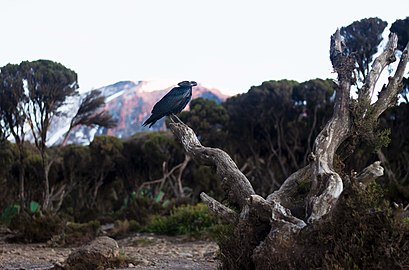Kilimanjaro National Park
3°04′S 37°22′E / 3.067°S 37.367°E / -3.067; 37.367
Kilimanjaro National Park is a Tanzanian national park located 300 kilometres (190 mi) south of the equator[1] in the Kilimanjaro Region, Tanzania. The park is located near the region of Moshi.[3] The park includes the whole of Mount Kilimanjaro above the tree line and the surrounding montane forest belt above 1,820 metres (5,970 ft).[1][3] It covers an area of 1,688 square kilometres (652 sq mi), 2°50'–3°10'S 37°10'–37°40'E.[1] The park is administered by the Tanzania National Parks Authority (TANAPA).[4] It was established as a national park in 1973. It was declared a World Heritage Site by UNESCO in 1987 and Natural Wonder of Africa in 2013.[5]
The Park Headquarters is at Marangu, about 44 Km from Moshi town and 86km from Kilimanjaro International Airport
The park generated US$51 million in revenue in 2013,[6]: 285 the second-most of any Tanzanian national park,[7]: 258 and was one of only two Tanzanian national parks to generate a surplus during the 2012–2013 budget year.[8] (The Ngorongoro Conservation Area, which includes the heavily visited Ngorongoro Crater, is not a national park.) TANAPA has reported that the park recorded 58,460 tourists during the 2012–2013 budget year, of whom 54,584 were foreigners.[8] Of the park's 57,456 tourists during the 2011–2012 budget year, 16,425 hiked the mountain, which was well below the capacity of 28,470 as specified in the park's General Management Plan.[9]
History
In the early twentieth century, Mount Kilimanjaro and the adjacent forests were declared a game reserve by the German colonial government.[3] In 1921, it was designated a forest reserve.[3] In 1973, the mountain above the tree line (about 2,700 metres (8,900 ft)) was reclassified as a national park.[1] The park was declared a World Heritage Site by the United Nations Educational, Scientific and Cultural Organization in 1987.[3] In 2005, the park was expanded to include the entire montane forest, which had been part of the Kilimanjaro Forest Reserve.[1][3]
Fauna
A variety of animals can be found in the park. Above the timberline, the Kilimanjaro tree hyrax, the grey duiker, and rodents are frequently encountered.[3] The bushbuck and red duiker appear above the timberline in places.[3] Cape buffaloes are found in the montane forest and occasionally in the moorland and grassland.[3] Elephants can be found between the Namwai and Tarakia rivers and sometimes occur at higher elevations.[3] In the montane forests, blue monkeys, eastern black and white colobuses, bushbabies, and leopards can be found.[3]
See also
Gallery
-
 White-necked raven on Kilimanjaro
White-necked raven on Kilimanjaro -
 The Mount Kilimanjaro
The Mount Kilimanjaro -
 Uhuru Peak - Mt.Kilimanjaro
Uhuru Peak - Mt.Kilimanjaro
References
- ^ a b c d e f "Kilimanjaro National Park World Heritage Site, Tanzania National Parks". Archived from the original on 30 September 2018. Retrieved 9 July 2013.
- ^ "Wings of Kili: Paragliding from Arica's highest peak". Daily News (Tanzania). Archived from the original on 29 January 2013. Retrieved 28 January 2013.
- ^ a b c d e f g h i j k Kilimanjaro National Park, World Heritage Center, United Nations Educational, Scientific and Cultural Organization
- ^ Mount Kilimanjaro National Park, Tanzania National Parks Authority Archived 2012-09-23 at the Wayback Machine
- ^ "Kilimanjaro National Park". Climbing Kilimanjaro. Archived from the original on 8 February 2023. Retrieved 15 January 2023.
- ^ Ghazali Musa; James Higham; Anna Thompson-Carr, eds. (5 June 2015). Mountaineering Tourism. Routledge. ISBN 978-1-317-66874-9.
- ^ Ian Christie; Eneida Fernandes; Hannah Messerli; Louise Twining-Ward (2014). Tourism in Africa: Harnessing Tourism for Growth and Improved Livelihoods. World Bank Publications. ISBN 9781464801976.
- ^ a b Park arrivals highlights, Tourism Performance, Corporate Information, Tanzania National Parks, accessed 9 November 2015 Archived 20 December 2015 at the Wayback Machine
- ^ "PRESS STATEMENT: NUMBER OF MOUNT KILIMANJARO CLIMBERS NOT A THREAT", Tanzania National Parks, 5 March 2014, accessed 31 July 2015 Archived 24 September 2015 at the Wayback Machine
External links

- Explore Kilimanjaro National Park in the UNESCO collection on Google Arts and Culture
- v
- t
- e

- Kilimanjaro National Park
- Kondoa Rock-Art Sites
- Ngorongoro Conservation Area
- Ruins of Kilwa Kisiwani and Songo Mnara
- Selous Game Reserve
- Serengeti National Park
- Stone Town of Zanzibar














